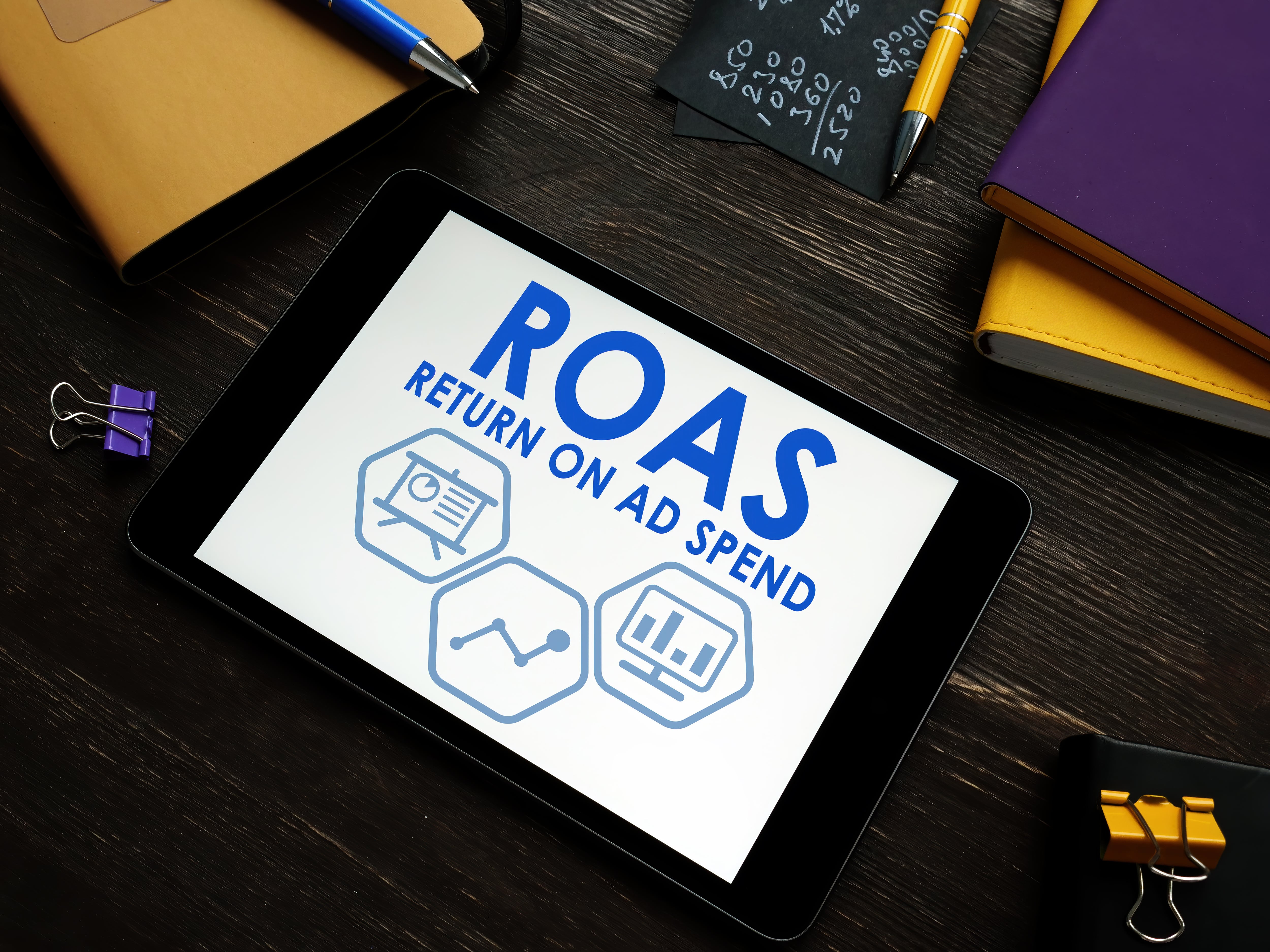
Yusuf Shurbaji
April 17, 2023
|
9.5
min read
You need to spend money to make money, but knowing how much bang you get for your marketing buck is essential. After all, knowing which ads offer the highest return is key to maximizing your marketing budget.
That's why you need to understand return on ad spend, or "ROAS." In addition, you need to know what a good ROAS is for your industry. That's easier said than done, but Prismfly is here to help you find the answers to all of these questions and more.

Return on ad spend is a vital marketing metric that tells you how much of a return you can expect for the money you spend on ads. Think of ROAS as a measurement of the revenue you generate per dollar spent on ads.
When you track ROAS, you can determine:
Here’s an example. If you make $9 of revenue per $1 spent, your ROAS is a ratio of 9:1. That’s very high. As you’ll see below, most companies can expect their ROAS to be about 4:1, at most.
Calculating ROAS is straightforward with the below formula:
In that formula, the total revenue is all the money you made from the target ad campaign or ad type (i.e., not the total revenue you've earned overall). The total ad spend is the total amount of money you spend on the target ad campaign.
Let’s look at a more specific example to break down this formula and see it in action. Imagine you have a total revenue of $20,000 from Ad Campaign A. You spent $9,000 on this ad campaign. Plug those numbers into the formula, and you get:
Rounding down, that’s a ratio of about 2:1. In other words, you made about $2 for every $1 you spent (or based on the above, about $2.22 per dollar spent).
Your return on ad spend tells you how much money you make for the money you spend on a given ad campaign/ad type.
For example, let’s say you have one advertising campaign with Google PPC, or pay-per-click advertisements. You also have another advertising campaign leveraging social media ads.
When you calculate the ROAS for both campaigns, you find the following values:
Both of these ROAS values are reasonably good. You’re making money for each dollar you spend. But it’s also true that the PPC ad campaign gives you a better return for the money you spend on those advertisements.
Given this information, you can make a few different decisions:
Bottom line: ROAS tells you how much money you’ve earned from an ad campaign relative to what you spent on it. When compared against other metrics, you can discover which ads perform the best and worst and make changes to your marketing strategy accordingly.
Many distinct factors can influence your return on ad spend, including:
Note that ROAS doesn’t measure the return on ad spend you get for a single advertisement. You can only use this metric to determine the money you get per dollar spent for an entire campaign or ad type.

The average company should hope to have a ROAS of 4:1, or to earn $4 for each $1 spent on advertising. However, industry specifics – such as the cost of equipment, the cost of running a business, and the cost of advertisements – can impact whether this is a feasible ratio.
Depending on your industry, an “ideal” ROAS might be higher or lower than that 4:1 mark. Different industries have different common ROAS values.
For example, a good ROAS in the TV industry is about 6.5:1, while a good ROAS for a radio company is closer to 4.95:1.
You can figure out a strong ROAS for your industry by considering a few key factors.
First, look at your profit margins. Your profit margins show you how much money you make after accounting for necessary costs, such as labor, materials, marketing, and more. The higher your profit margin is, the more “take home” money your business has to invest in itself, reward shareholders, or expand into new locations.
If you have low profit margins, a low ROAS is more acceptable since you likely need to spend more money on each advertising campaign you put out. For instance, you might operate in a very competitive industry with expensive keywords.
In such a case, a “low” ROAS of 3:1 or 2:1 might be excellent. Those returns on ad spend are strong – they indicate that you make more money on the advertisements you put out than you spend on them.
Average cost per click or CPC is the average amount of money you spend to earn a click from an ad. You might even pay for your online ads using a CPC pricing scheme.
If you don’t know the average cost per click of your brand’s ads, it’s easy to calculate. Divide the total CPCs your business earned over a given timeframe (like by month or quarter), by the total number of clicks.
Once you have your average CPC, you’ll know how much money you need to earn through ads to make it worthwhile. A high average CPC, again, means a lower ROAS is expected. Higher is always better, but if your ROAS is 2 or 3:1 instead of 4, don’t necessarily interpret that as a loss — make sure to look at it from the context of your industry standard.
Lastly, consider the size of your company. If your brand is bigger, try to shoot for a higher ROAS, such as 6:1 or more. Your brand likely has a more extensive customer base and a greater understanding of its target audience.
The reverse is true if your company is relatively small. You may need to spend more money on marketing and brand awareness at that stage before seeing significant returns on those investments.

While ROAS is an important metric to track and calculate, especially if you want to know how a specific ad campaign is performing relative to other marketing efforts, don’t forget other KPIs to track at the same time. Here are some examples.
CRO or conversion rate optimization isn't a distinct metric by itself, but it is something to push for as a brand. Optimizing your conversion rate – that is, the proportion of site visitors or leads who "convert" into paying customers or subscribers – is always a winning strategy. The greater the percentage of site visitors who convert into paying customers, the more money you can expect to make.
CRO as a practice is best adopted with a multifaceted approach. For example, you can use techniques like:
Fortunately, services like Prismfly can help you with conversion rate optimization and much more. As a specialized CRO and revenue-boosting brand, Prismfly is well-equipped and ready to help your company reach profit levels never seen before.
Sales lift is used to measure the effectiveness of a marketing campaign by comparing the increase in sales during that campaign to a baseline period. It helps you understand the impact your marketing efforts have on your revenue.
To calculate sales lift, follow these simple steps:
Keep in mind that sales lift doesn't pinpoint the campaign as the direct cause of the increase. However, it's a valuable insight into whether your ad campaign was a worthwhile investment when looking back at its performance.
ROI, or return on investment, is another key metric you should track alongside ROAS. This is partially because return on investment is very similar to ROAS.
In a nutshell, ROI tracks the monetary return (and thus, the overall performance) of many marketing efforts, such as email marketing, social media marketing, and online advertisements. ROAS, in contrast, measures the performance of one marketing campaign or ad type.
That said, ROI is still important to calculate and track over time. It’s an effective means to get a bird’s eye view of the quality and performance of your marketing efforts, especially in the long run. It's essentially the big-picture counterpart to ROAS.
Lastly, consider tracking and analyzing branded search volume, also sometimes called branded search traffic. Your branded search volume is the total volume of traffic that comes to your website using branded keywords via search engines such as Google, Bing, and more.
“Branded” keywords are search queries that use or are directly associated with your brand, product names, or branded services. For example, say you run a shoe company whose name is “Company A.” A branded keyword might be “Company A sneakers.”
Branded search volume tracks the traffic you receive from brand-specific keywords from the most important search engines. It’s an important metric because it tracks how often visitors and potential customers come to your site using keywords directly related to or inclusive of your brand, versus generalized keywords that bring in organic traffic (such as "trendiest sneakers" instead of “Company A sneakers”).
The higher your branded search traffic is, the more likely your brand is growing in market dominance and recognition among your target audience members.
Ultimately, a “good” ROAS depends on your industry, company size, profit margins, and the average cost per click you pay for online ads. Once you analyze each factor, you can calculate what a “good” ROAS looks like for your company specifically, then, adjust your marketing strategy appropriately to get as close to that ROAS as possible.
That’s much easier, of course, with Prismfly on your side. We offer services to solve a wide range of problems and help you scale business revenue across the board, including conversion rate optimization, UX and UI design, and much more.
Contact us today to see how we can help you maximize profits and conversion rate.

Yusuf Shurbaji
Co-Founder & Managing Partner
Yusuf Shurbaji has over a decade of ecommerce growth experience. His past work includes building optimization departments & running experimentation inhouse and agency side for Dior, JCPenney, LVMH, American Precious Metals Exchange, Princess Polly, Built Brands, Ladder Sport, Maze Group, HelloFresh, Ledger, Blockchain.com, Kind Snacks, and other 9-figure brands. Yusuf is a Co-Founder of Prismfly, a conversion rate optimization agency focused on growing revenue and EBITDA for D2C ecommerce brands. Prismfly is the first CRO focused Shopify Plus certified agency and has seen triple digit growth the past 2 years.
Yusuf Shurbaji




